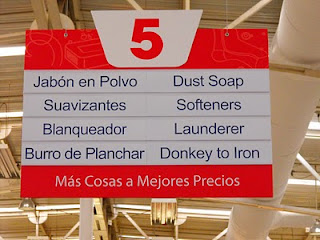
Rosetta Stone & I have a love/hate kind of relationship. This year I had two goals I wanted to accomplish during our winter in
“Rosie” is a bit of a devious bitch from time to time. She starts out with nice, easy words and phrases with lots of pretty pictures and all you have to do is match what the speaker says with the correct picture. As you progress through each lesson, you are asked to repeat what the speaker says. If you mispronounce a word you get a buzzer and have to try it again. The speaker only pronounces it once and you have as many chances as you need to get it right. Sometimes the tiniest inflection can be your undoing. I’ve had instances where I can’t even say “la” right! And what a taskmaster! Rosie will NOT let you skip it and move on. You just keep trying over and over and over until you get it right enough to get the bell! Then comes the REALLY difficult part! Rosie will present you with a dialog where you have to try to figure out what you need to say in response to someone else’s comment. Well…holy guacamole! I cannot even begin to tell you how far off I’ve been with this little exercise!
Fortunately, Rosetta is not my only source of learning. Mi esposo es un buen interprete…and thank goodness for that. When I go shopping and find something I want, I know enough to ask “cuanto cuesta?” but if the price is over “diez” (10) I am in way over my head!
I must say that I find it pretty easy to read Spanish much of the time. Many of the words we use in day-to-day language in the States. Things like taco, burrito, manana, adios, etc have become as common as English words like water or house. The difficulty comes when other, less known, words are added. For example, one day we were on a bus to
Loose translation: "Crocodile Zone. They eat dogs."
Here are some of the Spanish things I have learned just from taking buses and taxis around and reading signs:
If you had a headache, you might want to go to the farmacia for some aspirin.
If you are in immediate need of a hammer to pound a plug into a spewing thru hull then the ferreteria is the place for you.
Suppose you have had too many cervezas and desperately need to find a ladies room. Your best bet would be to find a bano. Of course, there are banos for caballeros and hombres which would be the wrong one! Yours would be the one for mujares or senioritas or…maybe…it just has a picture of a girl-type person on the door!
If you need a place to stay, depending on how long you want to be in the area, you might want to find a sign that says “se renta” (for rent)or “se venda”(for sale). Hotel is hotel in English or in Spanish.
“No Tire su Basura” means DON’T throw your garbage here while “Basura” is definitely where you DO put your garbage!
"Danger. Crocodile Zone.
No Swimming. No Dogs.
No Fishing. No throwing garbage."

One of the great things about the Mexican people is that they are very gracious and forgiving when you slaughter their language. They will do their best to understand what you are trying to say to them and I have never had anyone make fun of my mispronunciations. The hard part is when you are trying to learn Spanish and the person you are “conversing” with is trying to learn English. All sorts of interesting things take place.
It is comforting to know that the universal techniques of talking louder and slower, especially when combined with sign language and exaggerated facial expressions are still alive and well albeit totally ineffective.



2 comments:
Yes, I witnessed one fellow continue to raise his voice to the point of yelling, while mispronouncing the same words over, and over, and over.
If you can only count to diez, that just means you buy a lot of small things.
Kuddos to you for trying! So many people don't even begin to learn. They just become yellers.
(I recognize the photo of burro de planchar from Ley or Soriano in Guaymas. "Ironing Board")
Ja, so geht es. Mit eine andere sprache komt so viel lustige vehle. I hoffe das alles dir gut geht und das du keine burros zu hause mit bringt.
Post a Comment